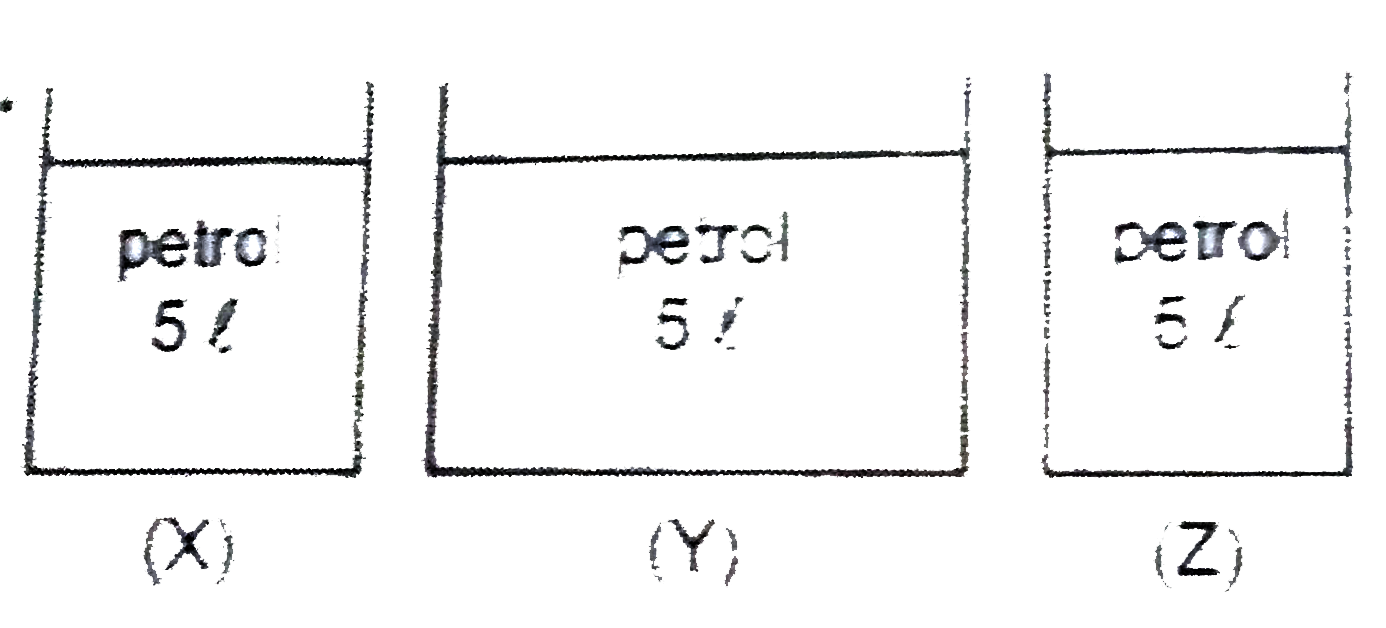 X,Y and Z containers are placed at 25∘C. Then decrease in temperature is more in __________ .
X,Y and Z containers are placed at 25∘C. Then decrease in temperature is more in __________ .
X
Y
Z
Cannot be predicted.
The correct Answer is:B
Petrol is a highly volatile and undergose evaporation, which causes cooling. Rate of evaporation is directly proportional to the surface area of the liquid. In case of container, "Y" rate of evaporation is more and hence decrease in temperature is more.
Topper's Solved these Questions
- CLASSIFICATION OF MATTERBOOK - PEARSON IIT JEE FOUNDATIONCHAPTER - CLASSIFICATION OF MATTEREXERCISE - LEVEL -3
5 Videos
- CLASSIFICATION OF MATTERBOOK - PEARSON IIT JEE FOUNDATIONCHAPTER - CLASSIFICATION OF MATTEREXERCISE - ASSESSMENT TEST 1
15 Videos
- CLASSIFICATION OF MATTERBOOK - PEARSON IIT JEE FOUNDATIONCHAPTER - CLASSIFICATION OF MATTEREXERCISE - CONCEPT APPLICATION LEVEL-1 MATCH THE COLUMN
3 Videos
- CLASSIFICATION OF MATTERBOOK - PEARSON IIT JEE FOUNDATIONCHAPTER - CLASSIFICATION OF MATTEREXERCISE - ASSESSMENT TEST (TEST-2)
9 Videos
- MOCK TESTBOOK - PEARSON IIT JEE FOUNDATIONCHAPTER - MOCK TESTEXERCISE - EXERCISE
25 Videos
Similar Questions
An open container is placed in atmosphere. During a time interval, temperature of atmosphere increase and then decreases. The internal energy of gas in container
View SolutionTwo containers X and Y are filled with water at different temperature. When 10 g of water from container X is mixed with 20 g of water from container Y, the resultant temperature is found to be 20∘C. When 20 g of water from container X is mixed with 10 g of water from container Y, the resultant temperature is found to be 30∘C. Determine the inital temperature of water in container X and Y.
View Solution
Knowledge Check
An open container is placed in atmosphere. During a time interval, temperature of atmosphere increase and then decreases. The internal energy of gas in container
AFirst increases then decreases because internal energy depends upon temperatureBFirst decreases then increasesCRemains constantDIs inversely proportional to temperatureA gas X at 1 atm is bubbled through a solution containing a mixture of 1MY− and 1MZ− at 25∘C. If the order of reduction potentials is Z>Y>X, then
AY will oxidise X but not ZBY will oxidise Zbut not XCY will oxidies both X and YDY will reduce both X and YA gas X at 1 atm is bubblcd through a soluution containing a mixture of 1MY−and1MZ−at25∘C. If the rcduction potential tial of Z>Y>X, then,
AY will oxidize X and not ZBY will oxidize Z and not XCY will oxidize both X and ZDY will reduce both X and Z
Two containers X and Y are filled with water at different temperature. When 10 g of water from container X is mixed with 20 g of water from container Y, the resultant temperature is found to be 20∘C. When 20 g of water from container X is mixed with 10 g of water from container Y, the resultant temperature is found to be 30∘C. Determine the inital temperature of water in container X and Y.
View SolutionThe temperature of equal masses of three different liquids x, y and z are 10∘C,20∘C and 30∘C respectively. The temperature of mixture when x is mixed with y is 16∘C and that when y is mixed with z is 26∘C. The temperature of mixture when x and z are mixed will be :
View SolutionGrapes placed in three beakers X ,Y and Z containing different type of solutions are shown in figures.

If beaker X contains water, Y and Z contain
View SolutionGrapes placed in three beakers X ,Y and Z containing different type of solutions are shown in figures.

If beaker X contains water, Y and Z contain
View SolutionAn open flask at 25∘C contains air. Calculate the temperature at which one fifth of air measured at 25∘C escapes.
View Solution
